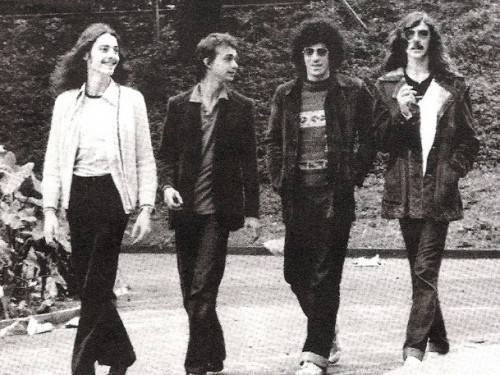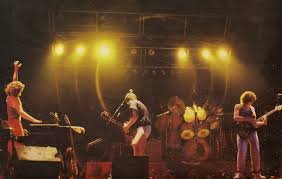ArgRock
Junior Member
- Joined
- Jul 4, 2013
- Posts
- 11
- Reaction score
- 0
Serú Girán was an Argentinian rock group. Formed in 1978, the group consisted of Charly García (keyboards, synthesizers and vocals), David Lebón (guitars and vocals), Pedro Aznar (Electric and fretless bass and vocals), and Oscar Moro (Drums and percussion). It is considered one of the best in the history of Rock in spanish, both musically, and conceptually and staging. It is also renowned for the virtuosity of its musicians.

After reaching a big success with his two past bands, "Sui Generis" and "La Maquina de hacer Pájaros", Charly García decided to start a new band project. Along with David Lebón, Charly García traveled to Búzios (Brazil) in 1978, with the idea of writing songs for a new album. On their return to Buenos Aires, García met the young and talented bass player Pedro Aznar. They were then joined by Oscar Moro, who was the drummer of La Máquina de Hacer Pájaros and formerly of the legendary group Los Gatos.
The beginnings of the band were difficult. Its first album, Serú Girán (released in 1978), did not have a good reception even though some of its songs (notably Seminare and Eiti Leda) would become public anthems. Seru wanted to transmit their message agains argentine dictature and opresion in an aesthetic way, betting for beauty in music, voices arrangements and lyrics. Garcia and Lebon also made the song "Seru Giran" (where the name of the band comes) in a complete new language, with pictures inside the album with the words on them, for people to understand. A lot of songs titles came from this language like "Seminare", "Eiti Leda" or "Cosmigonon". But people didn't get the message, they wanted artists who said things directly and giving a clear message agianst all suffering that Argentinian society was involve in.
The first public appearance of the band was in a boat over the Riachuelo.
The official presentation of the debut album "Serú Girán" was held in Estadio Obras Sanitarias on November 3 in 1978 with an orchestra of 24 musicians (string section and wind) and closed circuit television. In the back of the stage, a giant screen showing addressing the musicians on stage. Lebón, Aznar and Moro were dressed in white, while Charly chose a jacket, a black mesh bag and snickers. The beginning of the recital, with the full orchestra playing the powerful intro of the song Serú Girán, presaged an unforgettable night. However, it did not go well. The audience didn't get the satire behind the song Discoshock, which is about the disco music in vogue at the time, and was taken aback. Amid a chorus of whistles, the crowd asked the musicians to play Blues del levante, a song written by García at the end of his Sui Generis tenure. The rest of the concert went to general indifference.

Serú Girán released La Grasa de las Capitales a year later. The word "grasa" means "fat" in Spanish, but in Argentina it is also slang for vulgarity. As such, the title of the album was a criticism of the Argentine society in the 80's. "Perro Anadaluz" (Andalusian Dog) , "Viernes 3 A.M." (Friday 3 A.M,), and "Noche de Perros" (Dog's night) are the highest peaks of Serú Girán's second release. "Viernes 3 AM" would be banned from the radios for a time by the dictatorship because it was considered to incite suicide. This album catapulted Serú Girán as one of the most popular bands of Argentina of that time.
In 1980, the album Bicicleta ("Bicycle") was released. The album described with delicate and admirable accuracy the Argentine social and political times under the dictatorship. "Canción de Alicia en el país" and "Encuentro con el diablo" are the songs that best described that social reality. To avoid censorship, Canción de Alicia en el país painted Argentina's reality using metaphors inspired in Alice in Wonderland. Charly García described the feelings of early and middle adults in the songs A los jóvenes de ayer and Mientras miro las nuevas olas.
A month later, in August 1980, Serú performed at the Monterrey Jazz Festival of Rio de Janeiro (Brazil). In general, the Argentine going to the festival were more related to jazz or rock tango Serú proposed progressive.

Their 4th album Peperina was marked by the excellent and impeccable compositions such as Llorando en el espejo, Esperando Nacer, Cinema Verité and Peperina. The official presentation of the disc was held at Obras Sanitarias on 4, 5 and 6 September 1981. The album cover was designed by Clota Ponieman, with photos picked by him and Charly.
After that Aznar decides to leave the band to study at Berklee, that's how Serú organized a series of recitals to give him a farewell.
Serú Girán's future was uncertain. At beginning of 1982, the disc recorded in these concerts, No Llores por Mí Argentina, was one of the best selling ones in that year. The homonymous title became almost an anthem, and other songs like En la Vereda del Sol, Cuánto tiempo más llevará and Eiti Leda made of this record an essential album.
Later this year, the confrontations of García, Lebón and Moro (in particular the first two) on how to reeplace Aznar and the group's future made the band dissolve.

In 1992 Many years passed until the comeback of Serú Girán became a reality. García, Moro, Lebón and Aznar reunited to record Serú' 92. With the return of Serú, presentations were made in Rosario Córdoba (in stadium Chateau Carreras), Montevideo (Centenario Stadium) and in Buenos Aires with 2 performances at the stage of River Plate, the latter to about 160 thousand people in total. The return of Serú marked an historic record with no precedents at the time.

After reaching a big success with his two past bands, "Sui Generis" and "La Maquina de hacer Pájaros", Charly García decided to start a new band project. Along with David Lebón, Charly García traveled to Búzios (Brazil) in 1978, with the idea of writing songs for a new album. On their return to Buenos Aires, García met the young and talented bass player Pedro Aznar. They were then joined by Oscar Moro, who was the drummer of La Máquina de Hacer Pájaros and formerly of the legendary group Los Gatos.
The beginnings of the band were difficult. Its first album, Serú Girán (released in 1978), did not have a good reception even though some of its songs (notably Seminare and Eiti Leda) would become public anthems. Seru wanted to transmit their message agains argentine dictature and opresion in an aesthetic way, betting for beauty in music, voices arrangements and lyrics. Garcia and Lebon also made the song "Seru Giran" (where the name of the band comes) in a complete new language, with pictures inside the album with the words on them, for people to understand. A lot of songs titles came from this language like "Seminare", "Eiti Leda" or "Cosmigonon". But people didn't get the message, they wanted artists who said things directly and giving a clear message agianst all suffering that Argentinian society was involve in.
The first public appearance of the band was in a boat over the Riachuelo.
The official presentation of the debut album "Serú Girán" was held in Estadio Obras Sanitarias on November 3 in 1978 with an orchestra of 24 musicians (string section and wind) and closed circuit television. In the back of the stage, a giant screen showing addressing the musicians on stage. Lebón, Aznar and Moro were dressed in white, while Charly chose a jacket, a black mesh bag and snickers. The beginning of the recital, with the full orchestra playing the powerful intro of the song Serú Girán, presaged an unforgettable night. However, it did not go well. The audience didn't get the satire behind the song Discoshock, which is about the disco music in vogue at the time, and was taken aback. Amid a chorus of whistles, the crowd asked the musicians to play Blues del levante, a song written by García at the end of his Sui Generis tenure. The rest of the concert went to general indifference.

Serú Girán released La Grasa de las Capitales a year later. The word "grasa" means "fat" in Spanish, but in Argentina it is also slang for vulgarity. As such, the title of the album was a criticism of the Argentine society in the 80's. "Perro Anadaluz" (Andalusian Dog) , "Viernes 3 A.M." (Friday 3 A.M,), and "Noche de Perros" (Dog's night) are the highest peaks of Serú Girán's second release. "Viernes 3 AM" would be banned from the radios for a time by the dictatorship because it was considered to incite suicide. This album catapulted Serú Girán as one of the most popular bands of Argentina of that time.
In 1980, the album Bicicleta ("Bicycle") was released. The album described with delicate and admirable accuracy the Argentine social and political times under the dictatorship. "Canción de Alicia en el país" and "Encuentro con el diablo" are the songs that best described that social reality. To avoid censorship, Canción de Alicia en el país painted Argentina's reality using metaphors inspired in Alice in Wonderland. Charly García described the feelings of early and middle adults in the songs A los jóvenes de ayer and Mientras miro las nuevas olas.
A month later, in August 1980, Serú performed at the Monterrey Jazz Festival of Rio de Janeiro (Brazil). In general, the Argentine going to the festival were more related to jazz or rock tango Serú proposed progressive.

Their 4th album Peperina was marked by the excellent and impeccable compositions such as Llorando en el espejo, Esperando Nacer, Cinema Verité and Peperina. The official presentation of the disc was held at Obras Sanitarias on 4, 5 and 6 September 1981. The album cover was designed by Clota Ponieman, with photos picked by him and Charly.
After that Aznar decides to leave the band to study at Berklee, that's how Serú organized a series of recitals to give him a farewell.
Serú Girán's future was uncertain. At beginning of 1982, the disc recorded in these concerts, No Llores por Mí Argentina, was one of the best selling ones in that year. The homonymous title became almost an anthem, and other songs like En la Vereda del Sol, Cuánto tiempo más llevará and Eiti Leda made of this record an essential album.
Later this year, the confrontations of García, Lebón and Moro (in particular the first two) on how to reeplace Aznar and the group's future made the band dissolve.

In 1992 Many years passed until the comeback of Serú Girán became a reality. García, Moro, Lebón and Aznar reunited to record Serú' 92. With the return of Serú, presentations were made in Rosario Córdoba (in stadium Chateau Carreras), Montevideo (Centenario Stadium) and in Buenos Aires with 2 performances at the stage of River Plate, the latter to about 160 thousand people in total. The return of Serú marked an historic record with no precedents at the time.
Last edited:

